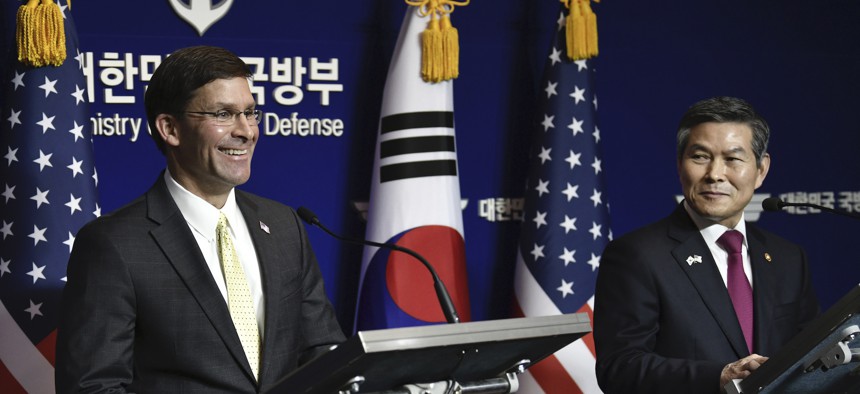
U.S. Defense Secretary Mark Esper, left, and South Korean Defense Minister Jeong Kyeong-doo, right, hold a joint press conference after the 51st Security Consultative Meeting (SCM) at the Defense Ministry in Seoul Friday, Nov. 15, 2019. Jung Yeon-je / Pool via AP
Esper, Milley Push South Korea to Pay More for US Troop Protection
South Korean Defense Minister Jeong Kyeong-doo declined to confirm reports that Trump is asking for a 400-percent hike.
SEOUL, South Korea — Defense Secretary Mark Esper on Friday pushed South Korea to contribute more money toward maintaining U.S. military forces on the peninsula, amid news reports that President Donald Trump is demanding the treaty ally quadruple its share.
“This is a very strong alliance we have, but Korea is a wealthy country and could and should pay more to help offset the cost of defense,” Esper said at a joint press conference after a meeting with his South Korean counterpart in Seoul.
South Korean Defense Minister Jeong Kyeong-doo declined to confirm that the U.S. side is asking for $4.7 billion, as CNN, Reuters and South Korean press outlets have reported.
“Discussions are currently ongoing,” Jeong said. “No matter what the total amount will be, I can assure you it will be in the range that takes the alliance further.”
Related: Challenges Pile up on US-South Korea Alliance Agenda
Related: On North Korea, the Chickens Are Coming Home to Roost
Related: South Korea's Tough Choice: The US or China?
He said that the amount will be decided at a “fair and mutually acceptable level.”
Chairman of the Joint Chiefs of Staff Gen. Mark Milley, also in Seoul this week, told reporters traveling with him the region that South Korea — a “very rich and wealthy” country — needed to explain its reticence to up its share of the bill.
For decades, the cost-sharing arrangement for keeping tens of thousands of U.S. troops in South Korea has been laid out by the Special Measures Agreement, which up until recently was renegotiated every five years. But in 2016, candidate Trump threatened to pull American troops from the peninsula unless South Korea contributed “100 percent” of the costs. Last year, when the SMA came up for renegotiation, Trump asked for a 50 percent cost hike. The two sides ultimately agreed to an 8 percent rise, and to renegotiate the agreement annually.
Trump previously has said that the cost of housing the 28,500 U.S. troops in South Korea is “$5 billion worth of protection,” a figure that fact-checkers say does not add up to the roughly $1.25 billion cost of the deployment — of which South Korea covered about 40 percent in 2018.
“South Korea is costing us $5 billion a year. And they pay — they were paying about $500 million for $5 billion worth of protection,” Trump said during a cabinet meeting in February.
The Trump administration has sought to increase the amount that allies and partners pay as part of various mutual defense arrangements, including aggressively pushing NATO allies to increase their defense spending to equal at least 2 percent of their GDP, per a nonbinding 2014 pledge.
“Generally the U.S. position is we look to all of our allies and partners to ensure they provide their fair share of the burden when it comes to defense,” Esper said. In South Korea’s case, “it is important to note that most of that money stays here in the country, easily over 90 percent of the funding.”
The demand comes at a time of heightened tensions with North Korea, which has launched dozens of missiles in 2019 in violation of UN Security Council resolutions. Trump has downplayed the launches, which are seen in South Korea and nearby Japan as a serious threat.
It also comes as U.S. allies across the globe have watched the United States’ abrupt withdrawal from Syria. That decision already had caused concern in foreign capitals about U.S. steadfastness under Trump, who has often expressed his ambivalence about U.S. military commitments overseas.
The U.S. presence in South Korea has traditionally not been controversial, although lawmakers have raised concerns in the past that South Korean contributions were not keeping pace with U.S. costs.
A 2013 Senate Armed Services Committee review led by then-chairman Sen. Carl Levin, D-Michigan, found that “South Korean SMA contributions are not keeping pace with the growth in U.S. costs.”
“For example, while South Korea’s estimated SMA contributions grew by about $42 million between 2008 and 2012 (from approximately $723 million to $765 million), U.S. non-personnel costs increased by more than $500 million during the same period ($592 million to nearly $1.1 billion),” according to the report.
Speaking to reporters traveling with him to Seoul on Wednesday, Esper said that the State Department is leading negotiations on burden sharing with South Korea.
“I'm not going to comment in particular on the talks, but I will be delivering the same message I've delivered to our allies in Asia, in Europe and elsewhere: And that is, there needs to be greater commitment to their own defense. And then there's burden-sharing, which goes beyond that,” Esper said.
“How do we offset U.S. costs for forward-deployed forces? That's the same message I've carried to all of our allies. It's the same message I will carry to South Korea.”
NEXT STORY: Erdoğan Defies Trump. So Why Do They Get Along?
